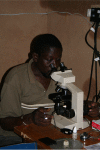"Test and treat" or presumptive treatment for malaria in high transmission situations? A reflection on the latest WHO guidelines
- PMID: 21599880
- PMCID: PMC3123602
- DOI: 10.1186/1475-2875-10-136
"Test and treat" or presumptive treatment for malaria in high transmission situations? A reflection on the latest WHO guidelines
Abstract
Recent WHO guidelines recommend a universal "test and treat" strategy for malaria, mainly by use of rapid diagnostic test (RDT) in all areas. The evidence for this approach is questioned here as there is a risk of over-reliance on parasitological diagnosis in high transmission situations, which still exist. In such areas, when a patient has fever or other malaria symptoms, the presence of Plasmodium spp neither reliably confirms malaria as the cause of the fever, nor excludes the possibility of other diseases. This is because the patient may be an asymptomatic carrier of malaria parasites and suffer from another disease. To allow clinicians to perform their work adequately, local epidemiologic data are necessary. One size does not fit all. If parasite prevalence in the population is low, a diagnostic test is relevant; if the prevalence is high, the test does not provide information of any clinical usefulness, as happens with any test in medicine when the prevalence of the tested characteristic is high in the healthy population. It should also be remembered that, if in some cases anti-malarials are prescribed to parasite-negative patients, this will not increase selection pressure for drug resistance, because the parasite is not there. In high transmission situations at least, other diagnoses should be sought in all patients, irrespective of the presence of malaria parasites. For this, clinical skills (but not necessarily physicians) are irreplaceable, in order to differentiate malaria from other causes of acute fever, such as benign viral infection or potentially dangerous conditions, which can all be present with the parasite co-existing only as a "commensal" or silent undesirable guest.
Figures




References
-
- WHO. Guidelines for the treatment of malaria (2e) 2. Geneva: World Health Organisation; 2010.
-
- WHO. Guidelines for the treatment of malaria. Geneva: WHO; 2006.
MeSH terms
Substances
LinkOut - more resources
Full Text Sources
Medical
Miscellaneous

